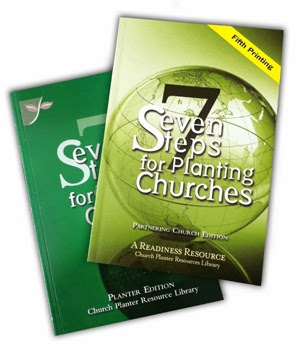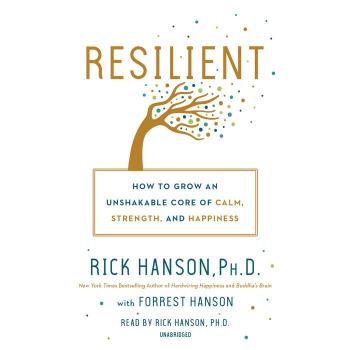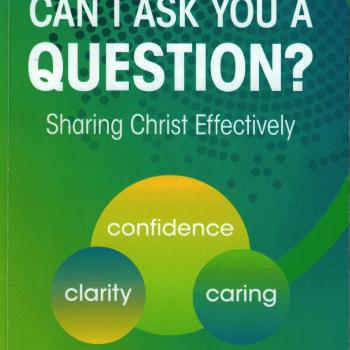
Seven Steps to Planting Churches by NAMB (SBC)
The primary insight that came from this book was the urgency and need to plant churches in the United States. The population to church ratio (2) reveals the need to plant more churches. In planting new churches, another insight was the use of the phrase “partner churches.” This language in how to identify new church plants (as opposed to a mother church, sponsoring church, or partnering church) is essential to starting new churches (3).
This book provides in its chapters a set of step-by-step instructions for a church which wants to plant a new church. The steps include (1) casting a vision for multiplying, (2) identifying the ministry focus group, (3) enlisting planters and partners while clarifying roles, (4) discover and commit resources, (5) mobilize sponsoring congregations, (6) support the birthing process and ongoing evaluation, and (7) celebrate and communicate church multiplication.
This small book also contains a set of tools that can be used in planting churches. These tools in the appendix include a partnering covenant template, a sponsoring church worksheet, suggested covenant guidelines for a Southern Baptist church plant, a sample partnering initiation checklist for the first fifty days, a planning calendar template, a church planting rationale (which would be very good in preaching a sermon to enlist partners and helpers), six church planting approaches, and a variety of other worksheets which can be used in assessing the effectiveness of a church plant (67-87). The book also lists contact information (89-93) and an extended bibliography (97-99) for further reading.
The book gives a variety of wise chapters concerning church planting. The author desires that a church plant should have at least two partnering churches when starting out. The author also stresses the need for a church planter which fits the community. He shares many places where a church planter can be found (25-26). The book also gives instructions about the roles for each partner in the process (27-32). It stresses the need for a written covenant, although I personally have not used one. Again, in hindsight, I would have followed that advice. (However, this reviewer should have read this book before starting a church.)
The hermeneutical foundation for church planting comes “straight out of the Great Commission” and the target is “all nations” (6). The foundation for this book is very evangelistic and thus conducive for church planting. A vision for planting church has it roots in the vision that God gave His servants in the Old and New Testament. “Vision will seldom come to those whose eyes are upon themselves and not upon the field of souls (John 4:35)” (7). The idea of a church which can become a church planting center that starts multiple churches has its basis in the church of Antioch (Acts 13:1-28). This book uses the church at Antioch as a biblical example (34). The book also describes Paul as the example who found multiple partners for his church planting process (Romans 15:24). Paul’s strategy is just as effective today as it was when he implemented it in the Roman Empire. He followed this pattern: (1) form a team to go, (2) as you go tell others about Jesus, and (3) as they believe organize them into churches (22).
This reviewer has difficulty believing that church split is an unplanned conception. In using the birth analogy for church planting, it seems that the idea of a church split is completely unplanned. However, my experience has shown that people in a church who split from one church and start another intentionally plan to do so. While the reasons may vary, many churches split over some issue. The analysis that churches who split should have multiplied into another church but did not is an interesting notion. However, I doubt many people who have gone through a church split would see it the same way. The hurt of a church split tends to inhibit the growth and maturity of the “new” church for many years. Church splits could then be considered unhealthy church plants.
This book was written in two separate editions: one for the partnering church and one for the church planter. While they both have the same title, the contents in the book are different. This complementary book is written specifically for church planters. If a church decided to sponsor another church, it would be wise to buy one for the partnering church pastor, and the church planter edition for the church planter. Taking time to review both books in one session would be beneficial.
This book compliments many other books. This book primarily focuses on the mechanics of starting a church. Other books which also address mechanics include Starting a New Church by Ralph Moore, Launch by Nelson Searcy and Kerrick Thomas, Planting New Churches in a Post-Modern Age by Ed Stetzer. Purpose-Driven Church written by Rick Warren also reveals the need for multiple partners in church planting in his own experience (Purpose Driven Church, page 37).
This book was written as a textbook and a how-to manual for church planters. It was written by the North American Mission Board and as a result, it reveals a strong preference for Southern Baptist churches. Its insistence that a church plant should give ten percent to the Cooperative Program is helpful for the Southern Baptist Convention. However, this amount may prohibit a church from starting other churches (as its title hopes each church to accomplish). Each church plant should have a strategy in place to multiply itself.
The book is short enough to read in one setting, yet it is packed with enough helpful information to keep a church planting busy. The appendices are helpful, yet it would be better if these were also available on the Internet to download and use. Overall, this book should be in every church planter’s library.












